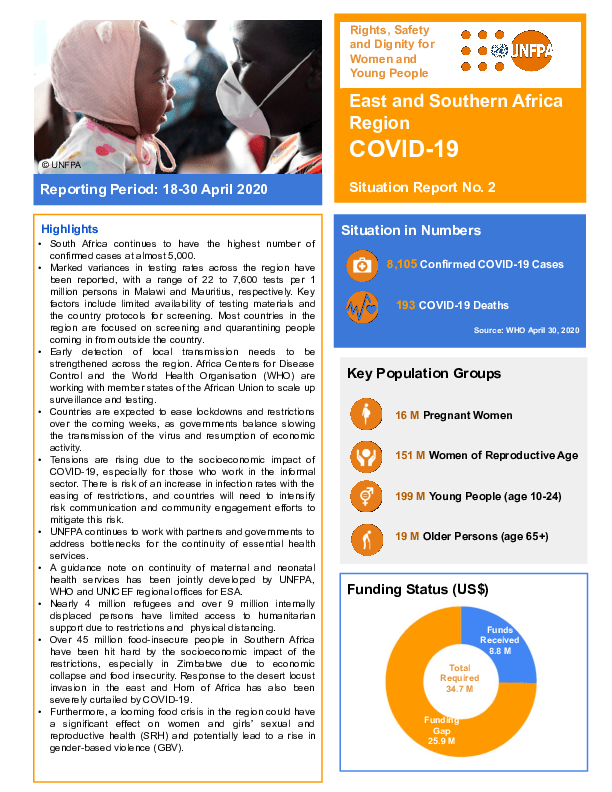
Resources
COVID-19 Situation Report No. 2 for UNFPA Eastern and Southern Africa
Resource date: May 2020
Author: UNFPA

Resources
Resource date: May 2020
Author: UNFPA
"The regional response aligns with the 2030 Agenda, the 2020 WHO COVID-19 Global Strategic Preparedness and Response Plan, the Inter-Agency Standing Committee, Global Humanitarian Response Plan and the UNFPA COVID-19 Global Response Plan."
"Coordination and partnerships"
"UNFPA country offices continue to engage with the governments, UN agencies and civil society partners in national coordination efforts. The main objective has been to ensure UNFPA’s mandate (SRH, GBV and population dynamics) is part of national response efforts, and that continuity of essential services in the three thematic areas is maintained."
"At the UN country team level, countries are working to ensure they leverage joint response and resource mobilization efforts of the country teams. Joint advocacy for continuity of essential services is ongoing in these teams. Countries with ongoing humanitarian crises are also working to ensure that COVID-19 is mainstreamed in the humanitarian response plans and programmes."
"At the regional level, UNFPA’s office is involved in the regional coordination forums including the Inter-Agency Standing Committee and Humanitarian Partnerships Team for Southern and East Africa. The regional GBV working groups are also supporting the countries to focus current programmes to respond to COVID-19 and address implementation challenges associated with COVID-19."
"Continuity of SRH interventions, including protection of health workforce
UNFPA has supported the continuity of essential SRH services by:
Supporting national- and local-level planning, coordination and monitoring to ensure access to SRH services. COs have provided programmatic guidance to ministries of health and advocated for interventions to address bottlenecks to service delivery, such as the movement of health workers and supplies;
Strengthening operational and logistics support to national supply chains, including providing personal protective equipment (PPE) to health workers, as well as facilitating additional supplies of modern contraceptives and other SRH commodities;
Supporting referral systems when public and private modes of transport have been constrained;
Supporting capacity-building efforts for frontline SRH workers and health facility optimization for COVID-19 through virtual training platforms and mentorships; and
Continuing to monitor the utilisation of services from both anecdotal and quantitative sources, through countries. The Kenya country office has demonstrated a marked drop in utilization indicators for SRH and GBV during March 2020. The data is being used for advocacy to address the bottlenecks to utilization of SRH and GBV services."